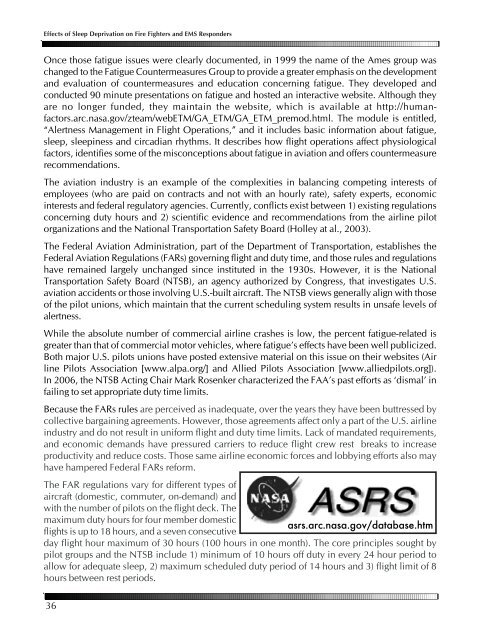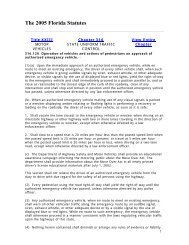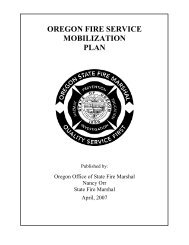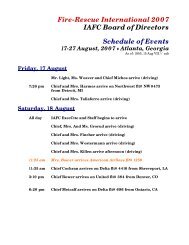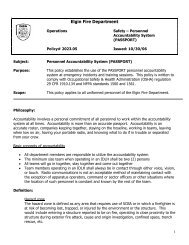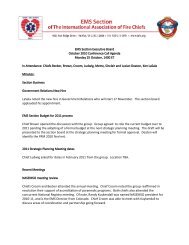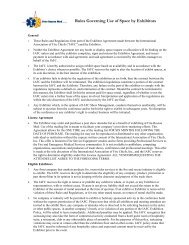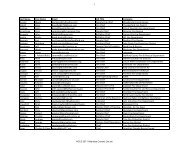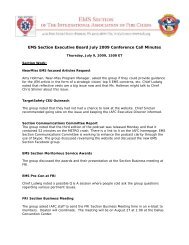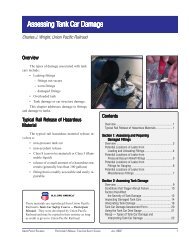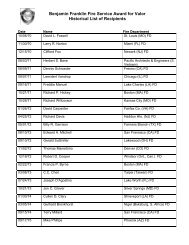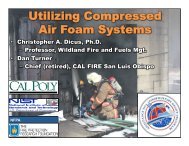Effects of Sleep Deprivation on Fire Fighters and EMS ... - NAEMT
Effects of Sleep Deprivation on Fire Fighters and EMS ... - NAEMT
Effects of Sleep Deprivation on Fire Fighters and EMS ... - NAEMT
Create successful ePaper yourself
Turn your PDF publications into a flip-book with our unique Google optimized e-Paper software.
<str<strong>on</strong>g>Effects</str<strong>on</strong>g> <str<strong>on</strong>g>of</str<strong>on</strong>g> <str<strong>on</strong>g>Sleep</str<strong>on</strong>g> <str<strong>on</strong>g>Deprivati<strong>on</strong></str<strong>on</strong>g> <strong>on</strong> <strong>Fire</strong> <strong>Fighters</strong> <strong>and</strong> <strong>EMS</strong> Resp<strong>on</strong>ders<br />
Once those fatigue issues were clearly documented, in 1999 the name <str<strong>on</strong>g>of</str<strong>on</strong>g> the Ames group was<br />
changed to the Fatigue Countermeasures Group to provide a greater emphasis <strong>on</strong> the development<br />
<strong>and</strong> evaluati<strong>on</strong> <str<strong>on</strong>g>of</str<strong>on</strong>g> countermeasures <strong>and</strong> educati<strong>on</strong> c<strong>on</strong>cerning fatigue. They developed <strong>and</strong><br />
c<strong>on</strong>ducted 90 minute presentati<strong>on</strong>s <strong>on</strong> fatigue <strong>and</strong> hosted an interactive website. Although they<br />
are no l<strong>on</strong>ger funded, they maintain the website, which is available at http://humanfactors.arc.nasa.gov/zteam/webETM/GA_ETM/GA_ETM_premod.html.<br />
The module is entitled,<br />
“Alertness Management in Flight Operati<strong>on</strong>s,” <strong>and</strong> it includes basic informati<strong>on</strong> about fatigue,<br />
sleep, sleepiness <strong>and</strong> circadian rhythms. It describes how flight operati<strong>on</strong>s affect physiological<br />
factors, identifies some <str<strong>on</strong>g>of</str<strong>on</strong>g> the misc<strong>on</strong>cepti<strong>on</strong>s about fatigue in aviati<strong>on</strong> <strong>and</strong> <str<strong>on</strong>g>of</str<strong>on</strong>g>fers countermeasure<br />
recommendati<strong>on</strong>s.<br />
The aviati<strong>on</strong> industry is an example <str<strong>on</strong>g>of</str<strong>on</strong>g> the complexities in balancing competing interests <str<strong>on</strong>g>of</str<strong>on</strong>g><br />
employees (who are paid <strong>on</strong> c<strong>on</strong>tracts <strong>and</strong> not with an hourly rate), safety experts, ec<strong>on</strong>omic<br />
interests <strong>and</strong> federal regulatory agencies. Currently, c<strong>on</strong>flicts exist between 1) existing regulati<strong>on</strong>s<br />
c<strong>on</strong>cerning duty hours <strong>and</strong> 2) scientific evidence <strong>and</strong> recommendati<strong>on</strong>s from the airline pilot<br />
organizati<strong>on</strong>s <strong>and</strong> the Nati<strong>on</strong>al Transportati<strong>on</strong> Safety Board (Holley at al., 2003).<br />
The Federal Aviati<strong>on</strong> Administrati<strong>on</strong>, part <str<strong>on</strong>g>of</str<strong>on</strong>g> the Department <str<strong>on</strong>g>of</str<strong>on</strong>g> Transportati<strong>on</strong>, establishes the<br />
Federal Aviati<strong>on</strong> Regulati<strong>on</strong>s (FARs) governing flight <strong>and</strong> duty time, <strong>and</strong> those rules <strong>and</strong> regulati<strong>on</strong>s<br />
have remained largely unchanged since instituted in the 1930s. However, it is the Nati<strong>on</strong>al<br />
Transportati<strong>on</strong> Safety Board (NTSB), an agency authorized by C<strong>on</strong>gress, that investigates U.S.<br />
aviati<strong>on</strong> accidents or those involving U.S.-built aircraft. The NTSB views generally align with those<br />
<str<strong>on</strong>g>of</str<strong>on</strong>g> the pilot uni<strong>on</strong>s, which maintain that the current scheduling system results in unsafe levels <str<strong>on</strong>g>of</str<strong>on</strong>g><br />
alertness.<br />
While the absolute number <str<strong>on</strong>g>of</str<strong>on</strong>g> commercial airline crashes is low, the percent fatigue-related is<br />
greater than that <str<strong>on</strong>g>of</str<strong>on</strong>g> commercial motor vehicles, where fatigue’s effects have been well publicized.<br />
Both major U.S. pilots uni<strong>on</strong>s have posted extensive material <strong>on</strong> this issue <strong>on</strong> their websites (Air<br />
line Pilots Associati<strong>on</strong> [www.alpa.org/] <strong>and</strong> Allied Pilots Associati<strong>on</strong> [www.alliedpilots.org]).<br />
In 2006, the NTSB Acting Chair Mark Rosenker characterized the FAA’s past efforts as ‘dismal’ in<br />
failing to set appropriate duty time limits.<br />
Because the FARs rules are perceived as inadequate, over the years they have been buttressed by<br />
collective bargaining agreements. However, those agreements affect <strong>on</strong>ly a part <str<strong>on</strong>g>of</str<strong>on</strong>g> the U.S. airline<br />
industry <strong>and</strong> do not result in uniform flight <strong>and</strong> duty time limits. Lack <str<strong>on</strong>g>of</str<strong>on</strong>g> m<strong>and</strong>ated requirements,<br />
<strong>and</strong> ec<strong>on</strong>omic dem<strong>and</strong>s have pressured carriers to reduce flight crew rest breaks to increase<br />
productivity <strong>and</strong> reduce costs. Those same airline ec<strong>on</strong>omic forces <strong>and</strong> lobbying efforts also may<br />
have hampered Federal FARs reform.<br />
The FAR regulati<strong>on</strong>s vary for different types <str<strong>on</strong>g>of</str<strong>on</strong>g><br />
aircraft (domestic, commuter, <strong>on</strong>-dem<strong>and</strong>) <strong>and</strong><br />
with the number <str<strong>on</strong>g>of</str<strong>on</strong>g> pilots <strong>on</strong> the flight deck. The<br />
maximum duty hours for four member domestic<br />
asrs.arc.nasa.gov/database.htm<br />
flights is up to 18 hours, <strong>and</strong> a seven c<strong>on</strong>secutive<br />
day flight hour maximum <str<strong>on</strong>g>of</str<strong>on</strong>g> 30 hours (100 hours in <strong>on</strong>e m<strong>on</strong>th). The core principles sought by<br />
pilot groups <strong>and</strong> the NTSB include 1) minimum <str<strong>on</strong>g>of</str<strong>on</strong>g> 10 hours <str<strong>on</strong>g>of</str<strong>on</strong>g>f duty in every 24 hour period to<br />
allow for adequate sleep, 2) maximum scheduled duty period <str<strong>on</strong>g>of</str<strong>on</strong>g> 14 hours <strong>and</strong> 3) flight limit <str<strong>on</strong>g>of</str<strong>on</strong>g> 8<br />
hours between rest periods.<br />
36


